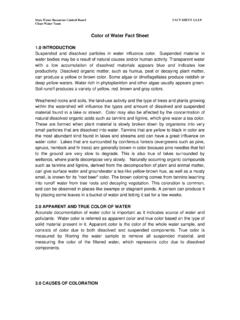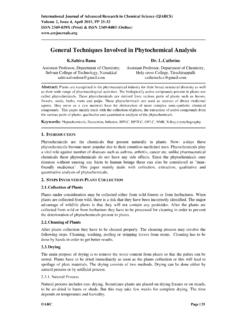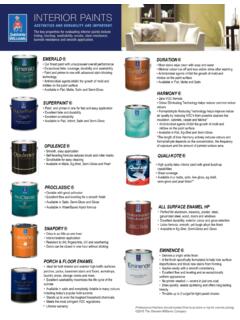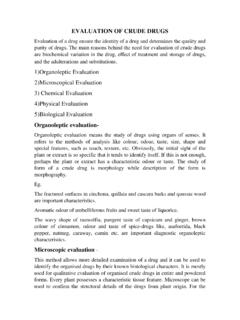Transcription of Core practical 2: Use a light microscope to observe and ...
1 Core practical 2 Teacher sheet EDEXCEL Biology B Teacher Resource Pack 1 Use a light microscope to observe and measure biological samples Core practical 2: Use a light microscope to observe and measure biological samples Objectives Be competent in the use of a microscope at high and low power, including the use of a graticule (eyepiece micrometer) to make measurements Know how to record observations using appropriate biological drawings Understand the importance of staining specimens in microscopy Safety Specification links Toluidine blue O stain is harmful if swallowed but is practical techniques 4, 5. not otherwise classified as hazardous.
2 However, CPAC 1a, 4a there is always the possibility of unknown effects and the stain should therefore be used with caution. Skin contact with toluidine blue O stain should be avoided. Wear gloves and eye protection when handling stain. Clean up any spills immediately and dispose of excess stain in the receptacle provided. To avoid cuts, take great care when using and carrying razor blades. Do not leave them lying on the desk. Your teacher will collect used blades and dispose of them in a sharps box. Ensure students understand the safe use of a microscope : warn against being vigorous with slides as they can splinter and advise on safe use of mounting needles.
3 Procedure 1. Before starting this core practical , familiarise yourself with the parts of the microscope and how to focus. Check that the lens and eyepiece are clean, using lens tissue to clean them if necessary as normal tissues or cloth can scratch lenses. If present, the condenser will need to be adjusted for each magnification. To correctly focus the condenser, place a slide on the stage and a pencil point on the light source, and adjust the condenser until both are in focus. If you use a mirror for illumination, take care not to use direct sunlight, as this can cause severe damage to eyes. Instead, use a bench-lamp where possible.
4 2. Calibrate the eyepiece graticule (see fig A in the Student sheet). Place a micrometer slide on the stage of the microscope . Using the low-power objective, focus on the micrometer scale. The smallest division of the micrometer scale is usually 100 m. Move the slide and rotate the eyepiece to align the scales of the eyepiece graticule and the stage micrometer in the field of view. Count the number of divisions (eyepiece units or epu.) on the eyepiece graticule that are equivalent to a known length on the micrometer slide and work out the length of each eyepiece 100. unit. For example, if 100 m is equivalent to 4 epu, then each epu is = 25 m at this 4.
5 Magnification. Repeat this for the medium- and high-power objectives. 3. Collect a piece of plant stem. Add a few drops of water to the centre of the white tile and wet the razor to reduce friction. Hold the plant stem firmly, keeping your fingers away from the edge of the razor. Cut several transverse sections, keeping them as thin as possible. Incomplete thin sections may sometimes be better than thicker complete ones. Use a brush to transfer the sections to water in a watch glass. 4. Select the two thinnest sections and place them on separate slides. Mount one in a drop of water, lowering a coverslip onto the section using the mounted needle and making sure there are no air bubbles.
6 practical activities have been safety checked but not trialled by CLEAPSS. Pearson Education Ltd 2015. Users may need to adapt the risk assessment information to local circumstances. This document may have been altered from the original 1. Core practical 2 Teacher sheet EDEXCEL Biology B Teacher Resource Pack 1 Use a light microscope to observe and measure biological samples 5. For the second stem section, remove excess water by carefully touching the edge with absorbent paper. Wearing glove and eye protection, add two drops of toluidine blue O stain and leave for 2 4 minutes. Add the coverslip as before and gently remove excess stain with a paper towel.
7 Toluidine blue O is a metachromatic stain, meaning that it reacts with different chemical components of cells to produce a variety of colours. This can provide information on the nature of the cell. Toluidine blue O stains lignin and tannins green to blue, pectins pinkish-purple, and nucleic acids purplish or greenish blue. 6. Turn the objective lens to low power. Examine first the unstained and then the stained slides under the microscope . To do this, bring the lens as close to the slide as possible while watching it side-on. Then, looking through the eyepiece, focus using the coarse focusing knob, moving the lens away from the stage.
8 This avoids damage to the slide and lens. Use the fine focus until a clear view of the section is established. Compare what can be seen in the stained and unstained slides. 7. For the stained slide, remain on low power and draw and annotate a simple outline plan of the section. Show the arrangement of tissues within the stem but do not include any cell details (see fig B in the Student sheet). 8. Using the eyepiece graticule, measure a vascular bundle and/or the stem diameter. Add a scale bar to your diagram. Add a title and include the magnification at which you made your observations. For example, with an eyepiece lens magnification of 10 and an objective of 10.
9 The total magnification will be 100. Remember this is not the same as the magnification of the drawing. 9. Now turn the objective disc to the medium power lens, again focusing until the cells are clear and distinct. Finally, turn the objective disc to high power lens and focus with the fine focusing knob only. Choose no more than 10 cells at the junction of two tissue types. Draw and label the detail of these cells as accurately as you can (see fig B in the Student sheet). 10. Measure the length and breadth of two cells. Record these measurements in your diagram. Notes on procedure Students should be shown how to cut the stems in a motion away from fingers to reduce risks of cuts.
10 Woody or tough stems should not be used. If stems are small it may be helpful to use a piece of pith (such as a carrot) with a notch cut out, placed on top of the stem to hold it steady. Alternatively, the material for sectioning could be held within a celery stem. Students often lack confidence in the correct use of microscopes. The microscopes used at A. level may be different to those used lower down the school. It is worth spending a few minutes to review how to use and care for the microscopes at the start of the lesson. Make sure that razor blades are counted in. Answers to questions 1. This will depend on the size of the drawing and the objective used.














